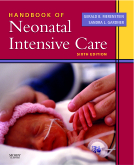Since it first published, the Handbook of Neonatal Intensive Care has
Handbook of Neonatal Intensive Care, 6th Edition
Merenstein & Gardner
Table of Contents
Unit I Evidence-Based Practice
1. Evidence-Based Clinical Practice Decisions
Unit II Support of the Neonate
2. Prenatal Environment: Effect on Neonatal Outcome
3. Perinatal Transport
4. Delivery Room Care
5. Initial Nursery Care
6. Heat Balance
7. Physiologic Monitoring
8. Diagnostic Imaging in the Neonate
9. Pharmacology in Neonatal Care
10. Drug Withdrawal in the Neonate
11. Acid-Base Homeostasis and Oxygenation
12. Pain and Pain Relief
13. The Neonate and Environment: Impact on Development
Unit III Metabolic and Nutritional Care of the Neonate
14. Fluid and Electrolyte Management
15. Glucose Homeostasis
16. Enteral Nutrition
17. Total Parenteral Nutrition
18. Skin and Skin Care
19. Breastfeeding the Neonate With Special Needs
Unit IV Infection and Hematologic Diseases of the Neonate
20. Newborn Hematology
21. Jaundice
22. Infection in the Neonate
Unit V Common Systemic Diseases of the Neonate
23. Respiratory Diseases
24. Cardiovascular Disease and Surgical Interventions
25. Neonatal Nephrology
26. Neurologic Disorders
27. Genetic Disorders, Malformations, and Inborn Errors of Metabolism
28. Neonatal Surgery
Unit VI Psychosocial Aspects of Neonatal Care
29. Families in Crisis: Theoretical and Practical Considerations
30. Grief and Perinatal Loss
31. Follow-up of the NICU Infant
32. Ethics, Values, and Palliative Care in Neonatal Intensive Care
been the mainstay reference for neonatal nurses. Co-edited and
authored by physicians, it focuses on the collaborative nature of
neonatal intensive care and examines evidence-based clinical decision-
making to demonstrate every aspect of the intensive care of the
neonate, with a strong emphasis on clinical practice. Key neonatal
topics are covered, and pathophysiology is examined using a systems
approach. Comprehensive enough for both physicians and nurses, this
handbook is a vital resource for those providing neonatal intensive
care.
Key Features
Multidisciplinary author and contributor team present a real-world
perspective similar to that experienced in the neonatal intensive
care unit.
Clinically applicable content is set in boldface type for easy
identification for busy neonatal care providers.
Evidence-based practice explained in the first chapter provides a
solid background with evidence-based rationales and references to
underscore its significance for neonatal health care providers.
Diagnostic Imaging chapter includes basic information on how
diagnostic imaging tests are evaluated.
Follow-Up Care chapter covers how health care providers should refer
the neonate and parents to appropriate care post-discharge from the
NICU.
Includes a Parent Teaching section for each disorder or relevant
section.
Infection in the Neonate chapter includes current immunization
recommendations for neonates.
Case studies illustrate important points when writing hospital orders
for the neonate.
New to this Edition
Parent Teaching feature highlights post-discharge care of the neonate.
Critical Findings feature, located in the assessment section of
disorders, helps the nurse prioritize data and steps in initial care.
Data Collection feature incorporates information that should be
included as part of the neonate’s history.
Table Of Contents
View Table of Contents
Author Information
By Gerald B. Merenstein, MD, FAAP, Professor of Pediatrics, Director,
CHA/PA Program, Senior Associate Dean, Education, University of
Colorado Health Sciences Center and School of Medicine, Aurora, CO;
and Sandra Lee Gardner, MS, RN, CNS, PNP,
Neonatal/Perinatal/Pediatric Consultant, Director, Professional
Outreach Consultation, Aurora, CO


